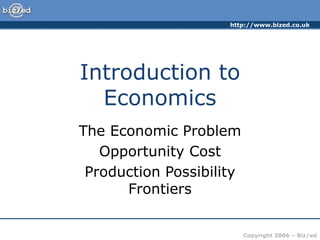economics intro.ppt
- 1. http://www.bized.co.uk Copyright 2006 ĻC Biz/ed Introduction to Economics The Economic Problem Opportunity Cost Production Possibility Frontiers
- 2. http://www.bized.co.uk Copyright 2006 ĻC Biz/ed The Economic Problem ? Unlimited Wants ? Scarce Resources ĻC Land, Labour, Capital ? Resource Use ? Choices A wind farm. Copyright: Getty Images, available from Education Image Gallery
- 3. http://www.bized.co.uk Copyright 2006 ĻC Biz/ed The Economic Problem ? What goods and services should an economy produce? ĻC should the emphasis be on agriculture, manufacturing or services, should it be on sport and leisure or housing? ? How should goods and services be produced? ĻC labour intensive, land intensive, capital intensive? Efficiency? ? Who should get the goods and services produced? ĻC even distribution? more for the rich? for those who work hard?
- 4. http://www.bized.co.uk Copyright 2006 ĻC Biz/ed Opportunity Cost ? Definition ĻC the cost expressed in terms of the next best alternative sacrificed ? Helps us view the true cost of decision making ? Implies valuing different choices
- 5. http://www.bized.co.uk Copyright 2006 ĻC Biz/ed Production Possibility Frontiers ? Show the different combinations of goods and services that can be produced with a given amount of resources ? No ĄŪidealĄŊ point on the curve ? Any point inside the curve ĻC suggests resources are not being utilised efficiently ? Any point outside the curve ĻC not attainable with the current level of resources ? Useful to demonstrate economic growth and opportunity cost
- 6. http://www.bized.co.uk Copyright 2006 ĻC Biz/ed Production Possibility Frontiers Capital Goods Consumer Goods Yo Xo A B Y1 X1 Assume a country can produce two types of goods with its resources ĻC capital goods and consumer goods If it devotes all resources to capital goods it could produce a maximum of Ym. If it devotes all its resources to consumer goods it could produce a maximum of Xm Ym Xm If the country is at point A on the PPF It can produce the combination of Yo capital goods and Xo consumer goods If it reallocates its resources (moving round the PPF from A to B) it can produce more consumer goods but only at the expense of fewer capital goods. The opportunity cost of producing an extra Xo ĻC X1 consumer goods is Yo ĻC Y1 capital goods.
- 7. http://www.bized.co.uk Copyright 2006 ĻC Biz/ed Production Possibility Frontiers Capital Goods Consumer Goods Yo Xo A .B C Y1 X1 Production inside the PPF ĻC e.g. point B means the country is not using all its resources It can only produce at points outside the PPF if it finds a way of expanding its resources or improves the productivity of those resources it already has. This will push the PPF further outwards.
- 8. http://www.bized.co.uk Copyright 2006 ĻC Biz/ed Positive and Normative Economics ? Health care can be improved with more tax funding ? Pollution control is effective through a system of fines ? Society ought to provide homes for all ? Any strategy aimed at reducing factory closures in deprived areas would be helpful ? Positive Statements: ĻC Capable of being verified or refuted by resorting to fact or further investigation ? Normative Statements: ĻC Contains a value judgement which cannot be verified by resort to investigation or research







